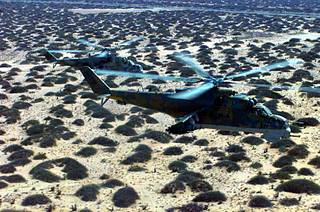
Similar
Оригинальная находка описывала эту фотографию следующим образом: Тематическая операция / серия: ROVING SANDS База: Fort Bliss Штат: Техас (Техас) Страна: Соединенные Штаты Америки (США) Оператор сцены: SRA Джим Шрайн, ВВС США Статус релиза: Обнародован Комбинированные цифровые графические файлы милицейской службы Два российских ударных вертолета Ми-24 имитируют наземные атаки на различные объекты ПВО на полигоне Дона-Ана в Форт-Блиссе, Эль-Пасо, штат Техас.
Резюме
Российские вертолеты эксплуатируются членами Optec Threat Support Activity на армейском аэродроме Биггс в рамках совместных учений ROVING SANDS '97, призванных улучшить возможности ПВО.
It’s common to describe the Hind as a “flying tank,” but “flying infantry fighting vehicle” is more accurate. Inventor Mikhail Mil’s initial mock-up of the V-24, which would become the Mi-24, had a resemblance with the U.S. Army’s UH-1 Huey of the Vietnam era. A flying infantry fighting vehicle was a pretty radical concept—and at first, the Soviet Defense Ministry was reluctant to back the project. But Mil won over the ministry with key features: two flight crew in tandem under a “greenhouse” armored canopy and glass, accommodation for eight fully armed troops, a gun, plus rockets and guided missiles. The design of the Mi-24 is based on a conventional pod and boom, with a five-blade main rotor and three-blade tail rotor. It has retractable tricycle nose-wheel landing gear. Considerable attention was given to making the Mi-24 fast. The airframe was streamlined, and fitted with retractable tricycle undercarriage landing gear to reduce drag. The first mass-produced variants, Mi-24A and Mi-24B had significant shortcomings due to inadequate rockets. In 1973, the Shturm-V rockets were ready and the first example of the definitive Hind appeared. With its superior range, flight speed, and accuracy, the semi-automatic-guided Shturm allowed the Mi-24 to excel in the close air support role. The Mi-24V went into production in 1976, and around 1,400 examples of this and the export Mi-35 rolled off the assembly line in the decade that followed. Mi-24P was a Mi-24V with a rapid-firing twin-barrel 30-millimeter gun mounted on the starboard side of the forward fuselage instead of the four-barrel gun turret. The new version entered production in 1981 and also yielded the Mi-35P export equivalent. For customers with the money, Russian Helicopters offers the Mi-35M with night and all-weather capability and modern air-to-ground and air-to-air guided missiles. As a combination of armored gunship and troop transport, the Mi-24 has no direct NATO counterpart. Besides protecting helicopter troop assaults and supporting ground actions, the Mi-24 also protected convoys, using rockets with flechette warheads to drive off ambushes; performed strikes on predesignated targets; and engaged in "hunter-killer" sweeps. Hunter-killer Mi-24s operated at a minimum in pairs, but were more often in groups of four or eight, to provide mutual fire support.
Теги
Дата
Месторасположение
Источник
Информация о правах



























































